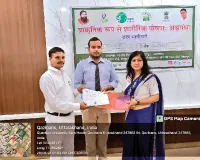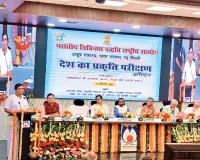Great form of Gurukuliya education
On

Dr. Acharya Sadhvi Devpriya
Vice Chancellor and Dean Patanjali University, Haridwar, Uttarakhand, India
One of the fundamental differences between Rukuliya education and general education is that in Gurukul, along with education, initiation also takes place. That is, as the disciple-guru studies and teaches, they also lead the same life, whereas in today's education, first the doctor engineer is taught, later he is practiced. Perhaps that is why, while leaving the Gurukul, he used to perform Samavartan (Sayak Avartan) rites that here in the Gurukul, this brahmachari performs the Right Varta frequency according to this education-initiation, this knowledge has become a part of his nature and now it is a divine personality and divine The leadership is ready. The aim of education should be to express one's entire divinity, not to impress anyone.
Education in ancient India was the key to the highest development of human personality operated for a specific purpose. This objective can only be achieved can occur when a person is at the level of body, mind, intellect and spirit to be refined. In front of this far-reaching objective of education keeping the ancient masters addressing their students said that.
Ravantu visve Amritasya Putra Aa Ye Dhamani Divyani Tashuh. [1]
Acharya used to use Vedas as the basis or proof and used to say that O sons of nectar. You become established in the divine abodes. Divya Dham means the highest level of consciousness we see in the Upanishads when a student named Satyakama Jabala comes to his guru for learning, the Acharya gives him 100 cows and sends him to the forest and instructs to come back when he is 1000 and says That only when they come back they will be able to teach them something.
When Satyakama comes back, the guru asks him that your spirit is shining with Brahmatej, who gave you this knowledge of Brahman? In response to Satyakam, it is said, Gurudev, this knowledge was given to me by the sun, by the directions, by the winds, by the cows, the rest Gurudev, you should subdue me. Gurudev says you do not need any knowledge, you have attained supreme knowledge. Therefore, in ancient times, the centers of education were located far from the cities in the lap of nature, in solitary-quiet regions where it easily united with that supreme being from all sides and progressed towards divinity.
Due to this unique education system, India not only provided cultural guidance to the world for centuries, but he was also a leader in all fields of science, agriculture, industry, art-skills, medicine, mathematics, constellations and science-technology. The purpose of ancient education was not only personal spiritual and material progress, but its goal was also inspired by the nation building and universal brotherhood, filled with folk spirit, in fact the root cause of the cultural and material prosperity of ancient India was the inclusive spirit of low life here, which It was continuously nurtured by the special education system of that period.
2. Location of Gurukuls
Upahrate Girinam Sangame Cha Nadinam, Ghiyo Vipra Ajayat I[2]I
Original nature is our basic culture - (Revered Swami Ramdev Ji Maharaj)
Today, environment is being considered as a compulsory subject in the new education policy, its core is the Gurukuliya education system. The student grew up with nature and progressed in the journey of life, being one with nature. In ancient times, the situation of learning centers was where there was enough land for agriculture and livestock, intensive gardens for eating fruits, flowers, tubers etc., availability of forests for sacrifice and the presence of lakes or rivers for water supply. This was the reason that often away from the villages, cities and districts, the foothills of the forests or suburbs, the hills or the abode or ashram of the Guru or Acharya situated on the banks of the rivers used to be the place of learning for all the learners.
3. Commencement of Education
Mother is the first guru from conception to 5 years, guru after 5 years in the disciple tradition, the teacher is the giver of knowledge.
In our culture, mother is considered as the first guru, who gives all kinds of education to the child from conception to infancy. Madalasa, the wife of King Mordhwaja, described in the Markandeya Mahapuran, teaches some of her sons about the path of retirement and while teaching the younger son Vikrant about the path of instinct. Similarly in Mahabharata also, mother Subhadra to Abhimanyu, Shakuntala to mother Bharata, Anjana to mother Hanuman and Chhatrapati Shivaji to mother Jijabai, etc., for the creation of excellent children, etc. Virtue, benevolence, good behavior, good manners, humility, valor, patience, seriousness, gratitude, service, hospitality, equanimity, companionship etc. Along with this, Gurukul used to inspire the children for education by making them aware of alphabets and script knowledge. It is a sacred tradition to perform the Upanayana ceremony before the commencement of the education of children. In which almost all the scholars, accepting the opinion of Maharishi Manu, consider the minimum age of the student to be appropriate from 05 to 11 years.
Brahmavarchasakamasya Karya Viprasya Panyame I
Ragno Balarthinah: Shashthe Vaishyasyeharthinoshtme. [3]
Scientists also believe that the brain glands of children become mature for education only after the first 5 years of life. The basic goal of education is to inculcate modesty and moral values in human beings. It is only after having the best qualifications that a person attains all kinds of wealth and attains eternal happiness by virtue of wealth and righteous conduct. There is a very famous verse-
Vidya Dadati Vinayam Vinayaddati Patratram I
Patratvad Dhnamapnoti Dhnaddharmam Tatah Sukham (4).
Vinitveshena Praveshtavyani Tapovanani (5)
In order to inculcate respect in the people towards the Gurukulas, the kings themselves, without taking off their dignified robe, umbrella and crown, without taking the bodyguards and attendants, entered the ashram premises in a very humble manner, getting down from their vehicles and entering on foot present the model.
4. Upanayan and Vedarambha rituals
Upanayan literally means to be close to the Guru.
Acharya Upanayamano Brahmacharinam Krinute Garbhamanatah I
Tam Ratristidda Bibharti Tam Jatam Drashtumabhisanyanti Devah I [6]
Like a mother, Guru or Acharya performs the entire responsibility of upbringing, education and protection with infinite patience.
After entering the Gurukul, the students used to enter the Grihasthashram after getting education till the age of about twenty five years. Generally the students who studied in the Gurukul till the age of twenty-four were called Vasu Brahmachari, those who studied till the age of thirty-six were called Rudra Brahmachari and those who studied till the age of forty-eight were called Aditya Brahmachari. There were also some of these students who, after the normal period of study for special education, took admission in the Gurukuls of eminent masters for further studies.
5. Purpose of ancient education, internal and external discipline
The ancient teachers explained this important truth of internal discipline formed the first basis of education:
(i) Antarkaran Chattaya - Without understanding the nature and nature of the inner being, the process of knowledge cannot be accelerated. According to Philosophy, there are four forms of the inner mind - mind, intellect, mind and ego. Even more important than the knowledge of the nature of external causes and its use, it is more important to have knowledge of the nature of the inner (mind, intellect, chit, ego) and its functioning, because Even externalities are able to complete all their activities with the help of the inner being. If he does not know how to operate the machinery of the mind by whose contemplation and high thoughts he has to achieve the highest ideals of life, then all the activities will fail. Intellect- With the help of which all the big decisions are to be made in life, Guru used to introduce such an important yantra at the very beginning of life, because as a person's thoughts and decisions are, so is his world and life. Acharya used to teach his disciple in childhood itself, how the sanskars acquired from time immemorial, can be attained or destroyed by the strong yogic sanskars of the present day.Ego means personal identity of Acharya in Gurukul
Aham Brahmasmi [7]
‘Kasya Brahmacharyasi Pranasya Brahmacharyasi Kastvakamupanayate Kaya Tya Tva Paridadamiti’ [8]
This sattvik ego is the only one who does the welfare of the individual and the whole used to have it. In this way, only by controlling the conscience, a person can transform himself into an ideal human by developing the sublime qualities of goodness, conscience, kindness, generosity, compassion. Therefore, in order to fulfill the resolution of becoming an ideal human, one should try to understand and become well aware of the inner workings through Gurukuliya education.
(ii) Panchkoshiya Vidya- In the Upanishads, the origin of the soul, the origin, condition, development and speed of destruction of the universe has been explained through Panchkosh. All these Panchkoshas divide human consciousness into five parts.
a) Annamaya Kosha – The journey, whether external or internal, starts from where the person is standing. The student coming to Gurukul is still standing on the surface of the body (ie Annamay Kosh), so the advance journey also starts from here. Nowadays, such big and big diseases are arising in small children, they reflect the lack of gurukuliya education of parents somewhere. Upon coming to the Gurukul, the Guru first used to preach and initiate physical progress, the means of which are - Sattvic diet, systematic routine and exercise, this strengthened the disciple's Annamaya Kosha.
b) Pranamaya Kosha - This Pranamaya Kosha, which fills all the senses with energy, radiance, enthusiasm, happiness, is the means of the power of this Kosha, whose ritual is done in the morning and evening in the Gurukul.
c) Manomaya kosha - Manomaya kosha is satisfied by sublime thoughts, sattvik thoughts, positive thoughts, concentration and the means of all these are pratyahara and dharana. Study of Arsha texts and chanting of holy mantras like Omkar, Gayatri etc. also satisfies and strengthens Manomaya kosha. Memorizing scriptures in Gurukuls are also divine means to increase concentration. This must have been the reason that Valmiki ji had made Luv-Kush remember the entire Ramayana in his childhood. 24000
d) Vigyanamaya kosha – With the strengthening of this kosha, a person gets a sense of satisfaction, contentment, and satisfaction. Such a person is constantly satisfied and always lives in self-competition. The means of developing this fund is meditation, which in the Gurukul itself makes the disciple practice through his conduct.
e) Anandamaya Kosha - This is the best place for the highest development of human consciousness. At this level of consciousness, the seeker experiences great words like 'Aham brahmasmi'] [9].
Dharana, Dhyana Samadhi are its divine means. To the students of today, all these things seem like Mayalok. But in the Gurukuliya education, the Guru used to make the disciple's consciousness visible to the gods through his tenacity and sacrifice. That is, the confirmation of the body, the power of life, the satisfaction of the mind, the satisfaction of the intellect and the liberation of the soul, this is the inner development.
(iii) Ashtan Yoga- By the practice of Ashtan Yoga, the decay of impurities and the brightness of knowledge increases continuously and eventually the person becomes fully-conscious and becomes from human to Mahamanava and from Nara to Narayana. Swami Vivekananda repeated the exclamation of the Upanishads to absorb this situation: Uttishthat Jagrat Prapya Varannibodhat [10] The practice of asanas, pranayama, pratyahara and dharana made the disciple's intellect so intensely subtle and concentrated that he became a master of not one but many sciences within a few years. In the Gurukula teachings, the rules are described as vows and the Yamas as Mahavrata and in all respects, always to be observed: Vraten Deekshamapnoti Deekshayapnoti Dakshinam, Dakshinam Shraddhamapanoti Shraddhaya Satyamapnoti [11] The sitting of Saraswati, the goddess of all knowledge, on a lotus flower or on a swan indicates that knowledge resides only in the pure consciousness. The lotus always rises above the mud and the swan is water-milk discerning. Maharishi Dayananda had completed all the Vidyas in just three years and at present my Gurudev Param Pujya Swami Ramdev Ji Maharaj is a direct example of this.
(iv) Sanskar Siddhanta - The physical, mental, intellectual, moral and spiritual level of the students can be improved only by the education given on the basis of sanskars, this is the reason why Gurukuliya education consists of sixteen sanskars along with the experimental method of sanskar process. High priority was also given to the knowledge of The glory of the samskaras is so great that a person's transformation takes place by this method. How can a child growing up in the eternal devotion of the mother be able to adopt such a harsh life of Gurukul, this question can easily come in anyone's mind. But after hearing the answer, your soul will also be satisfied.
Acharya Upanayamano Brahmacharinam Krinute Garbhamantah I
Tam Ratristdda Udare Bibhartim Tam Jatam Drashtumabhisamyanti Devoh [12]
That is, just as the child used to reside in the mother's inner side, in the same way, it resides in the inner side of the guru, and on the day it is born from this womb, the deities also come to see it, that day it is called dvija, i.e. Born again Rama, Krishna, Maharishi Dayanand, Swami Vivekananda and at present my Gurudev are such dvijas. It is very rare to find such a sublime analogy of the guru-disciple relationship in any country other than India. For a newcomer to the Gurukul, see the divinity of the Guru's assurance to the disciple,
Mam Vrate te Hridayam Dadhami Mam Chittam Aapika te Astu,
Mama vachan ekmana jushasva, brihasishtva niyunaktu mama. [13]
That is, I take your heart in my heart, I take your mind in my heart, that is, two souls are uniting together today. The Guru is taking the responsibility of making the best of the heart and mind of the disciple in his own hands and he is making this Vedic proclamation in front of everyone in the gathering. Can anyone imagine a higher aim of education? Just as the Guru here is taking such a big responsibility of creating one's divine personality, in the same way, by getting the yagyopaveet introduced to the disciple through its three threads, by introducing the sages, the ancestors and the gods, by tying the Mekhla, that is, by tightening his waist, he should also follow the same tradition. being prepared for discharge. This is the sacred tradition of 16 sacraments which are taught only in Gurukul.
External Discipline - Serving the Guru or Acharya while maintaining strict discipline and maintaining pure conduct and having exclusive reverence for him, sleeping on earth, getting up in Brahma Muhurta, worshiping and doing Pranayama before sunrise, maintaining the ashram It was mandatory for everyone to arrange food, wear simple clothes, perform sacrifices, and have equal education. The students of Gurukul were also given the education of beggary so that they remain emotionally connected with the society. The education of Gurukulas used to be free. In this way, with the spirit of universal universal fraternity, in the open environment of nature, with the spirit of universal universal fraternity, this practical education, the conduct of the inner knowledge of the learners was sparkled, i.e. the manifestation of a divine personality was in the Gurukuls. . These divine talents who were groomed in the Gurukulas provided divine leadership in different areas of the world according to their abilities and interests. Due to this great tradition of the great gurus of Gurukul, this country of India was called Guru in the world. The responsibility of divine creation of the whole world was on India, it is still today and will always be. of this immense responsibility today my Gurudev and revered Swami Ramdev Ji Maharaj is doing the same with a laughter.
6. Types of Vidyas
In the Gurukuls, training was given in all kinds of disciplines. Such as Anvikshiki, Vedatrai, Varta and Dandneeti, these four disciplines are going to stabilize public behavior.
Imastu Chatuddo Vidyah Prithavaprasthanah Pranabhritamanugrahayopadishyante I [14]
Yasam Chaturthiyamanveekshiki Nyayavidya I
Pradeepah Sarvavidyahnamupayah Sarvakarnam I
Ashshrayah Sarvadharmananrvidyoddeshe Prakeertita II (14)
Along with this, Angiras (song, dance and fine arts), Sarpavidya (Toxicology), Devajanvidya (study of the ill effects on human life), Mayavidya (the activities of non-Aryans and their resistance measures), Rashavidya (mathematics knowledge), Devavidya (estimation of natural events and measures to avoid them), Nidhividya (money related), Ekayan (ethics), Brahmavidya (spirituality), Bhootvidya (zoology), Kshatravidya (war skills), Nakshatravidya (body structure and radiation) and Vakovakya etc. all the education was given.
Apart from these, vocational education, industrial education, medical science, agricultural science and animal husbandry and veterinary education were also given. Similarly, knowledge of constellations and bodies through astronomy and practical education of various subjects under science and technology was given. were done as follows.
On the basis of these subjects, some major departments were established in Gurukuls -
1. Fire place (for sacrifice rituals)
2. Brahma Sthana (for self-knowledge)
3. Vishnu Sthan (Science of Creation)
4. Mahendra Sthan (War Skills and Military Education)
5. Vivasvat Sthan (Astrology / Nakshatra Vidya) 6. Soma Sthan (Udbhij-Vigyan)
7. Garuda Sthan (Traffic)
8. Kartikeya Sthan (array-creation and weapons-research) 9. Vishwakarma Sthan (craft and architecture)
10. Indra Sthan (Politics / Economics Education)
11. Dhanvantari-Sthan (Ayush and Pharmaceutical Sciences)
12. Angiras Sthan (song, music and fine arts) etc.
Structures of departments in modern universities
To continue ….
Tags: patanjali patanjali wellness yog sandesh education india Great form of Gurukuliya education bharat university of patanjali bharat swabhiman patanjali yog samiti swami ramdev ji maharaj patanjali gurukulam acharyakulam patanjali research institute Acharya balkrishna patanjali yogpeeth patanjali yog sandfdesh yog gram yog guru haridwar devbhumi mahila patanjali yog samiti patanjali ayurvedic hospital
लेखक
Related Posts
Latest News
01 Dec 2024 18:59:48
योग प्रज्ञा योग - योग जीवन का प्रयोजन, उपयोगिता, उपलब्धि, साधन-साधना-साध्य, सिद्धान्त, कत्र्तव्य, मंतव्य, गंतव्य, लक्ष्य, संकल्प, सिद्धि, कर्म धर्म,...








.jpg)







.jpg)


1.jpg)
.jpg)
